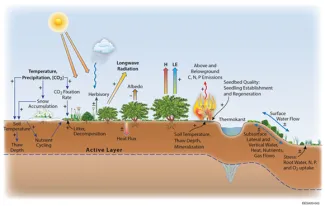A woodier Arctic will alter the carbon balances by affecting a complex set of soil-plant-atmosphere interactions.
Vegetation composition shifts, and in particular, shrub expansion across the Arctic tundra are some of the most important and widely observed responses of high-latitude ecosystems to rapid climate warming. These changes in vegetation potentially alter ecosystem carbon balances by affecting a complex set of soil-plant-atmosphere interactions. In this review (Mekonnen et al., 2021b), scientists working with the NGEE Arctic project synthesize the literature on (1) observed shrub expansion, (2) key climatic and environmental controls and mechanisms that affect shrub expansion, (3) impacts of shrub expansion on ecosystem carbon balance, and (4) research gaps and future directions to improve process representations in land models. A broad range of evidence, including in situ observations, warming experiments, and remotely-sensed vegetation indices have shown increases in growth and abundance of woody plants, particularly tall deciduous shrubs, and advancing shrub lines across the circumpolar Arctic. This recent shrub expansion is affected by several interacting factors including climate warming, accelerated nutrient cycling, changing disturbance regimes, and local variation in topography and hydrology. Under warmer conditions, tall deciduous shrubs can be more competitive than other plant functional types in tundra ecosystems because of their taller maximum canopy heights and often dense canopy structure. Competitive abilities of tall deciduous shrubs vs. herbaceous plants are also controlled by variation in traits that affect carbon and nutrient investments and retention strategies in leaves, stems, and roots. Overall, shrub expansion may affect tundra carbon balances by enhancing ecosystem carbon uptake and altering ecosystem respiration, and through complex feedback mechanisms that affect snowpack dynamics, permafrost degradation, surface energy balance, and litter inputs. Observed and projected tall deciduous shrub expansion and the subsequent effects on surface energy and carbon balances may alter feedbacks to the climate system. Land models, including those integrated in Earth System Models, need to account for differences in plant traits that control competitive interactions to accurately predict decadal- to centennial-scale tundra vegetation and carbon dynamics.
Citation: Mekonnen, Z. A., W. J. Riley, L. T. Berner, N. J. Bouskill, M. S. Torn, G. Iwahana, A. L. Breen, I. Myers-Smith, M. García-Criado, Y. Liu, E. S. Euskirchen, S. J. Goetz, M. C. Mack, and R. F. Grant. 2021a. “Arctic tundra shrubification: a review of mechanisms and impacts on ecosystem carbon balance.” Environmental Research Letters 16: 053001. https://doi.org/10.1088/1748-9326/abf28b.


